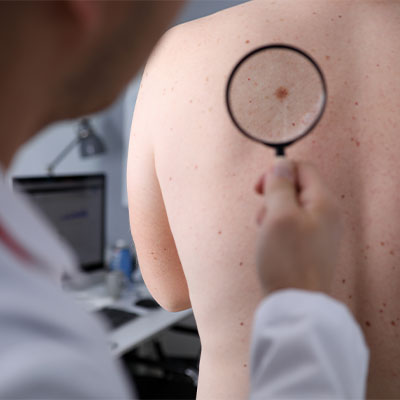Skin Biopsies
Skin Biopsies
A skin biopsy is the removal of skin cells from your body for laboratory examination. Your provider uses a skin biopsy to diagnose skin conditions or remove abnormal tissue.
Three types of skin biopsies are:
- A shave biopsy is done with a razor-like tool to remove a small section of the top layers of skin (epidermis and a portion of the dermis). Pressure and a topical medication are applied to stop bleeding.
- A punch biopsy is done with a circular tool to remove a small core of skin, including the layers below the epidermis and dermis. Stitches may be needed to close the wound, and a bandage is placed over the wound to prevent bleeding and to provide protection from infection.
- An excisional biopsy is done with a small knife (scalpel) to remove an entire lump or area of abnormal skin down to or through the fatty layer of skin. Stitches are usually needed, followed by bandaging.

Your provider will send the skin biopsy sample to a laboratory for testing and evaluation. Results may take several days or longer, depending on the type of biopsy and the lab’s procedures. Your provider or assistant will either call you with the lab results or schedule an appointment to discuss the results.
A skin biopsy is generally a safe procedure, but complications can occur, including bleeding, bruising, infection, scarring, and allergic reactions.
Before the skin biopsy, tell your provider if you:
- Are allergic to local anesthetics, topic antibiotics, antiseptics, or topical tapes
- Have been diagnosed with a bleeding disorder or had any excessive bleeding after other medical procedures
- Are taking blood-thinning medications, such as aspirin, warfarin, or heparin
- Are taking supplements or homeopathic medications as these can sometimes cause bleeding when taken with other medications
- Have a history of skin infections, such as impetigo
What to Expect with a Skin Biopsy
Depending on the location of the skin biopsy, you might need to undress and get into a gown. Your provider will clean the area of skin to be biopsied, and a mark may be put around the site.
You will receive a local anesthetic, usually by needle, to numb the biopsy site. This might feel a little hot at first. To make sure the anesthetic is working, your provider will prick your skin with a needle to see if you feel anything.
A skin biopsy typically takes about 15-20 minutes, including the preparation time, dressing the wound, and instructions for at-home care.
,After the skin biopsy, your provider may instruct you to keep the bandage over the biopsy site until the next day. If the site bleeds (more likely if you take blood-thinning medications), apply direct pressure for intervals of 20 minutes. If bleeding continues after that, contact your doctor. Do not soak in a bathtub, hot tub, or pool for about seven days after the procedure or until your provider says it is okay.
Clean the biopsy site two times a day unless it’s on your scalp — then clean it once a day. Follow these steps:
- Wash your hands with soap and water before touching the biopsy site.
- Wash the biopsy site with soap and water. If the biopsy site is on your scalp, use shampoo.
- Rinse the site well.
- Pat the site dry with a clean towel.
- After the area is dry, apply a thin layer of petroleum jelly (Vaseline). Use a new container of petroleum jelly the first time you do wound care. Use a new cotton swab each time you apply the petroleum jelly.
- Cover the site with an adhesive bandage (Band-Aid) for the first two or three days after the procedure.
- If your wound is sore, ask your provider if you can apply ice wrapped in a thin towel.
Continue wound care until the stitches are removed or, if you don’t have stitches, until the skin is healed.
Wound healing can take several weeks. Wounds on legs and feet tend to take longer than those on the body. All biopsies create a small scar, and sometimes a prominent, raised scar (keloid) develops. The likelihood of a raised scar is increased when the biopsy was done on the neck or upper torso. Scars fade gradually and its color can take years to diminish.
Call us today at Catawba Valley Healthcare for all of your skin care concerns at (828) 695-5900.
